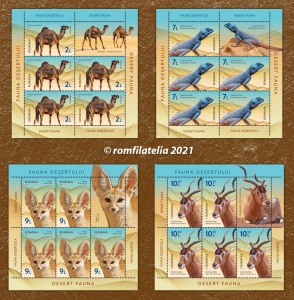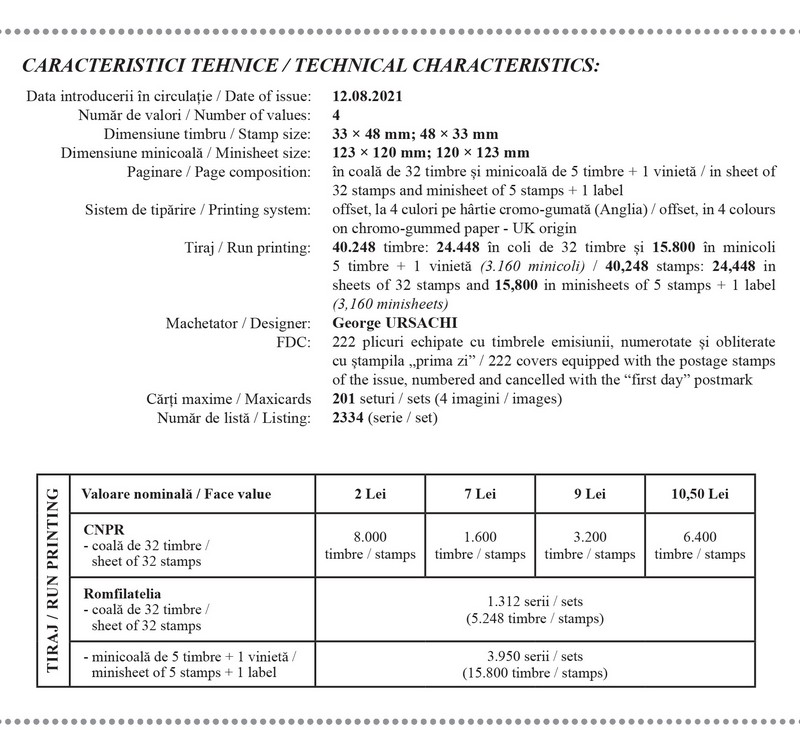Romfilatelia introduces into circulation, on Thursday, August 12th, 2021, a postage stamps issue with a topic approached for the first time: Desert Fauna.
Deserts occupy about a third of the land area and are characterized by a very low level of precipitation. Not all deserts are found in the hot regions of the planet; there are also cold deserts, as some regions of the Arctic and Antarctic are considered. The largest hot desert in the world is the Sahara (in Africa). In contrast, the Gobi Desert in Asia is generally a cold desert, where temperatures can drop below -20 degrees Celsius in winter. In deserts, aridity creates harsh living conditions for living things, and they have special adaptations to survive.
The four stamps and the First Day Cover illustrate animal species living in the desert areas of Africa and Asia.
On the first stamp of the series, with the face value of Lei 2.00, is illustrated the dromedary (Camelus dromedarius). This herbivorous mammal has a single hump, in which fat is stored, which serves as a source of energy during periods without food. It has many adaptations that allow it to withstand the conditions of life in the desert: it can withstand the loss of up to 30% of the amount of water in the body; the nostrils may close to protect the airways during sandstorms; the eyes are protected from dust and sand due to long and thick eyelashes; the legs are provided with wide hooves, which facilitates walking on sand, etc. It lives mainly in the hot and arid areas of North and East Africa, as well as in Asia – in its centre and west and in the Indian subcontinent. Most dromedaries are domestic; in Australia, however, there is a population of over 500,000 wild dromedaries, which come from specimens imported in the 19th century.
The Sinai agama (Pseudotrapelus sinaitus) is represented on the stamp with the face value of Lei 7.00. It is a small reptile that lives in arid areas of north-eastern Africa and southwest Asia. It has a length of up to 18 cm. The body colour is usually light brown, but in the mating season the males turn blue. Females have red spots above the limbs. Sinai agamas feed on insects (especially ants) and plants, being active during the day.
The fennec fox (Vulpes zerda) is represented on the stamp with the face value of Lei 9.00. It is a species of fox that lives in the Sahara, the Sinai Peninsula and the Arava and Negev deserts of Israel. It is the smallest species in the canid family (which includes foxes, dogs, wolves, jackals, etc.). The very large ears help dissipate heat and locate prey. Although widespread, it has disappeared from some areas, due to its capture for commercial purposes, as well as the expansion of human settlements.
The addax antelope (Addax nasomaculatus) is illustrated on the stamp with the face value of Lei 10.50. It is a species native to the Sahara, very well adapted to the conditions of life in the desert. It can survive for a long time without drinking water, obtaining the necessary water from dew and the plants it feeds on. Once widespread in North Africa, the addax antelope is now a critically endangered species, with probably fewer than 500 individuals living in the wild. A large number of specimens are bred in captivity.
The First Day Cover of the issue depicts the Bactrian camel (Camelus bactrianus), also known as the “two-humped camel”, native to the steppe and desert areas of Central Asia. Adapted to the difficult conditions in this region, it withstands water shortages and very large temperature variations. Most of the population consists of domestic animals, with a smaller number of wild specimens in Asia and Australia.
Romfilatelia thanks the Institute of Biology of the Romanian Academy and “Grigore Antipa” National Museum of Natural History for the documentary support offered to the development
of this postage stamps issue.




